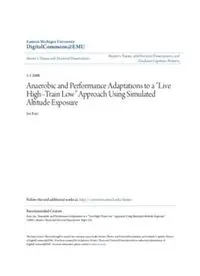
“Live High–Train Low” Approach Using Simulated Altitude Exposure PDF
Preview “Live High–Train Low” Approach Using Simulated Altitude Exposure
Eastern Michigan University Anaerobic and Performance Adaptations to a “Live High–Train Low” Approach Using Simulated Altitude Exposure By Ian Ratz Thesis Submitted to the School of Health Promotion and Human Performance Eastern Michigan University in partial fulfillment of the requirements for the degree of MASTER OF SCIENCE in Exercise Physiology Thesis Committee: Stephen McGregor, Ph.D., Chair Andrew Coggan, Ph.D. Christine Karshin, Ph.D. Tony Moreno, Ph.D. July 15, 2008 Ypsilanti, Michigan Acknowledgements This research could not have been completed without the help and assistance of several groups. I would like to take a moment to thank: USA Swimming for making significant contributions to this study by awarding a $5,000 research grant for supplies and expenses, a $2,000 student scholarship, and for supplying this project with two Hypoxico Altitude Training Systems throughout the study. Andrew Coggan Ph.D. for collaborating on the study’s design, serving on my thesis committee, and for generously loaning me his personal altitude tent. The Athletic Training Department at Eastern Michigan University, specifically Bill Tuscany, for allowing the use of the SciFit Arm Ergometer. All of the individuals who gave their time to participate in the study. The members serving on my thesis committee: Steve, Chris, Tony, and Andy. Thank you for your support and guidance throughout this rewarding process. The individuals who assisted with data collection in the laboratory, specifically Tim Muth, Zack Maino, Mike Busa, and Ben Caldwell. There were more than 130 hours of testing that occurred in 4 months, and I could not have done this alone. My family and Kayla for their never-ending encouragement and support throughout Graduate School. ii Abstract The purpose of this study was to determine if a seven-day live high–train low (LHTL) simulated altitude exposure could improve (a) anaerobic and/or aerobic capacity (VO2peak) in trained cyclists (n = 10) and (b) VO2peak and/or 400m swimming performance in collegiate swimmers (n=8). In procedures approved by the EMU Human Subjects Review Board, cyclists performed seven cycle ergometer trials to measure maximal mean power output (MMPO4min), maximal accumulated oxygen deficit (MAOD), and VO2peak, whereas swimmers completed five incremental arm ergometer trials (VO2peak) and 400m swimming performance trials before and after LHTL. No significant changes were observed in any measured parameter. Therefore, the conclusion of this study is that a 7- day simulated altitude exposure of 2,500m for 8.5 hours each night is insufficient to result in changes in MAOD, VO2peak, or performance among highly trained cyclists and swimmers. iii TABLE OF CONTENTS Acknowledgements………………………………………………………………..……...ii Abstract…...…………………………………………………………………………...…iii Chapter I: Introduction …………………………………………........................................1 Statement of the Purpose……………………………………………………….....3 Significance………………………………………………………….……………3 Research Questions…………………………………………….………….…….4 Asumptions……………………………………………………….……….….4 Limitations…………………………………………………………..……….……4 Delimitations…………………………………………………………..….…….....5 Definition of Terms……………………………………………………....………..5 Chapter II: Review of Literature ………………………………………………………….8 Introduction……………………………………………….……………………….8 Approaches to Altitude Exposure…………………………………………8 Intermittent Altitude Exposure............................... ………………9 Live High–Train Low Approach………………..……………….11 Optimal Exposure of Altitude……………………………........................13 Elevation of Simulated Altitude………………………………….14 Duration at Simulated Altitude……………...………...................17 Performance Evaluation………………………………….………………19 Aerobic………………………………………...............................19 Anaerobic………………………………………..……………….22 Chapter III: Methods………………………….…………………………………….……30 iv Introduction………………………….…………………………………….….…30 Inclusion Criteria and Sample Recruitment…………………….….…….30 Part I: Maximal Accumulated Oxygen Deficit Adaptations …………………….31 Description of Sample……………………………………………………31 Procedure……………………………………………………………….31 Testing Measures……………………………………………………….32 Maximal Mean Power Output in 4 Minutes……………………..32 Maximal Accumulated Oxygen Deficit……………………….…35 Part II: Aerobic and Swimming Performance Adaptations….…………………..37 Description of Sample……………………………………………………37 Procedure……………………………………………………………….37 Testing Measures……………………………………………………….38 Peak Oxygen Consumption……………….…………………….38 Swimming Trials……………………...……………………….…40 Common Procedures for Testing Cyclists and Swimmers………………………42 VO2peak Measurement…………………………………………………….42 Blood Lactate Analysis…………………………………………………..44 Simulated Altitude……………………………………………………….44 Logbook………………………………………………………………….47 Data Analysis………………………………………………………….…47 Chapter IV: Results………………………………………………………………………48 Cyclists………………………………………………………………………….48 Subject Characteristics………………………………………………….48 v Atrition………………………………………………………………….50 Peak Oxygen Consumption………………………………………………52 Maximal Accumulated Oxygen Deficit………………………………….52 Research Question 1…………………………………………………….54 Lactate……………………………………………………………………54 Power…………………………………………………………………….54 Logboks…………………………………………………………………5 Simulated Altitude Exposure…………………………………………….57 Swimmers…………………………………..........................................................59 Subject Characteristics………………….59 Atrition………………………………………………………………….61 Peak Oxygen Consumption………………………………………………64 Swim Performance Time………….…………………………………….64 Research Question 2…………………………………………………….68 Lactate……………………………………………………………………68 Power…………………………………………………………………….69 Time to Exhaustion………………………………………………………69 Logboks…………………………………………………………………70 Simulated Altitude Exposure…………………………………………….72 Chapter V: Discussion…………………………………………………………………...75 Performance Results…………………………………………………………….76 Peak Oxygen Consumption……………………………………………………...77 Maximal Accumulated Oxygen Deficit ………………………………………....81 vi Blood Lactate Concentration…………………………………………………….83 Power Output…………………………………………………………………….84 Time to Exhaustion……………………………………………………………....85 Responders vs. Non-Responders…………………………………………….….85 Limitations……………………………………………………………………….86 Direction of Future Research…………………………………………………….88 Conclusion…………………………………………………………………….8 References…..……………………………………………..…………………………......90 APPENDIX A Cyclists Informed Consent …………………………………..………….99 APPENDIX B Swimmers Informed Consent…………………………………………..103 APPENDIX C Altitude Tent Exposure Supervisor Informed Consent………………...107 APPENDIX D Cyclists Logbook…………………………………………………...….110 APPENDIX E Swimmers Logbook…………………………………………………….113 APPENDIX F Human Subject Approval Form………………………………………...116 APPENDIX G Manufacturer’s Oxygen Equivalents…………………………………...118 vii LIST OF TABLES Table Page 1 Cyclists study design…………………………………………………………….36 2 Swimmer’s study design…………………………………………………………41 3 Cyclist characteristics………………………………………………….……….49 4 Physiologic results during cycle ergometer tests.………….………………….....51 5 Cyclist’s workout logbooks………………………………………………..….…56 6 Cyclist’s simulated altitude exposure……………………………………..……..58 7 Swimmer characteristics……………………………………………………….60 8 Physiologic results during arm ergometer tests…………………….…………....62 9 Performance results from the 400 meter swim trials………………………….…63 10 Swimmer’s workout logbooks……………………………………………….…..71 11 Swimmer’s simulated altitude exposure……………………………………..…..73 viii LIST OF FIGURES Figure Page 1 Velotron Cycle Ergometer………………………………………………….……34 2 SciFit Pro II Arm Ergometer………………………………………………….….39 3 Jaeger Oxycon Mobile Metabolic Cart……………………………………….….43 4 HYP 100 Hypoxic Generator……………………………………………….……45 5 Hypoxic Altitude Tent……………………………………………………….…..46 6 MAOD differences between groups and trials …………………….…..…….…..53 7 400 meter performance time differences between groups and trials………….....65 8 Control performance results between trials as individuals………………………66 9 Altitude performance results between trials as individuals………….…………..67 10 Altitude exposure sleep quality for cyclists and swimmers………………….…..74 ix
